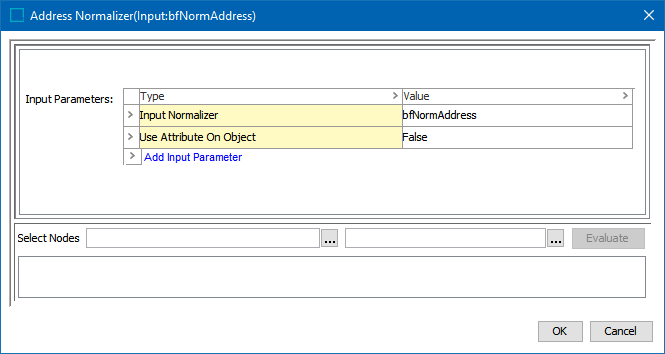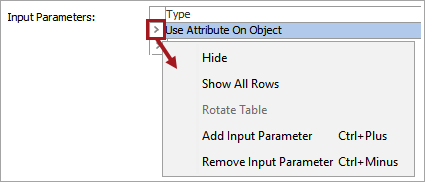The address normalizer produces a normalized set of addresses for use in the corresponding address matcher.
Prerequisites
Configure the address component model (defined in the Address Component Model section of the Data Integration documentation here).
Input
The following data is provided by the input address element attributes mapped to the address component model. The address object uses the input attribute values or, if the Standardized Zip is set, the address object is populated using the standardized attributes.
|
Input Attributes |
Standardized Attributes |
|---|---|
|
|
When configuring the data element, the Input Parameters field allows selection of:
-
'Use Attribute on Object' – by default, this option is set to ‘True’ and indicates to read attributes on the object itself. Click the Value dropdown to manually set it to 'False' when using information from a Data Container or an Input Normalizer.
-
'Data Container' – read attributes from the data container.
-
‘Input Normalizer’ – read outputs from the selected Match Expression, as defined in the Matching Algorithms and Match Expressions topic here.
Output
The output of the address normalizer is a class: java.util.Set<com.stibo.partydatamatching.domain.address.Address>
For more information on the contents of the class, refer to the STEP API Documentation on the STEP Start Page and review the documents linked from within the Scripting API section.
Functionality
The address normalizer automatically makes the following modifications to the address in the order listed for comparison purposes only:
-
All elements – remove leading and trailing white space
-
Country – lower-case text
-
Country ISO – remove characters other than Latin letters and numbers
-
Region – lower-case text
-
City – lower-case text
-
Postal code – remove all spaces, remove dash (-) characters, lower-case text
-
Street – lower-case text
Because address information varies between systems and countries, it is sometimes necessary to chain address normalizers. For an example of adding a custom address normalizer business function that further normalizes the address after the standard normalizer runs, refer to the Data Elements: Business Function Normalizer topic here.
Configuring an Address Normalizer Data Element
After adding the address normalizer in the Data Elements flipper of the Decision Table dialog (defined in the Match Criteria topic here), configure it as follows:
-
Click into the Data Elements column and click the ellipsis button (
 ) to access the configuration dialog.
) to access the configuration dialog.
-
On the address normalizer dialog:

-
For the Input Parameters, define the source of the data to be normalized. Refer to the Input section above for details.
Right-click the arrow in the first column of the Input Parameters table for additional display and edit options. Although it appears that the default 'Use Attribute On Object' parameter can be removed, after closing the dialog it will continue to display. Instead, if a different input parameter is used, click the Value dropdown and manually set 'Use Attribute On Object' option to 'False.'

Click the Add Input Parameter link to add other input parameters.

-
-
To test the configuration, for the Select Nodes parameters:

-
Click the ellipsis button (
 ) for each field and select two objects for comparison.
) for each field and select two objects for comparison. -
Click the Evaluate button.
An empty result field indicates the value is not available in the selected node. Adjust as indicated by the Evaluator results and repeat the evaluation.
-
-
Click OK to save and display the configuration in the Data Elements flipper. Click into a Comment cell to add relevant information as desired.
